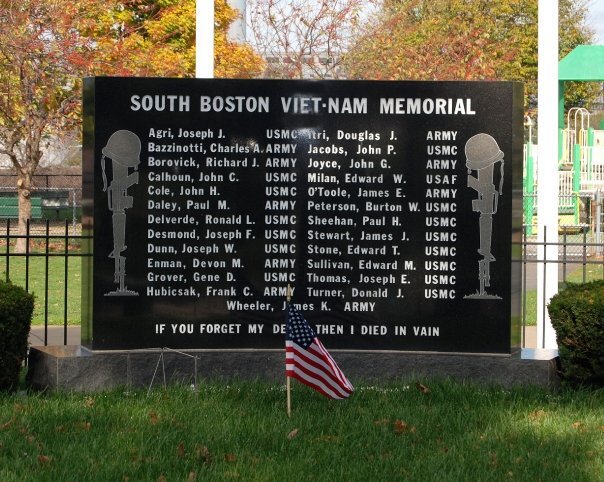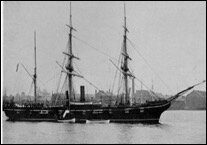Preserving History
“Preserving History”
By: MAJ Dave Falvey , MAARNG G-5 Plans Officer & AFCC member
One of the things I love about living in South Boston is its history of military service, and its commitment to paying tribute to those who served. Examples of this can be found at Medal of Honor Park, home to one of the first formal Vietnam War memorials in the country, dedicated in 1981. The park itself is named in honor of the three South Boston residents to have earned the Medal of Honor: PVT George H. Nee, PVT Frank O. Walker, and PFC Michael J. Perkins, whom the Natick Armory is named in honor of. Along the Boston Harborwalk, you’ll also find memorials to honor those Southie lost in the Korean War, as well as World War II, and both are beautiful tributes to those who made the ultimate sacrifice.
But not all memorials in Southie are holding up so well these days. Memorials, like most things, require maintenance, and this requires an entity taking on the role of ensuring a particular memorial receives that attention. The USS Kearsarge Memorial at Marine Park is an example of a memorial that slipped through the cracks. It consists of a large anchor mounted on a concrete base that is cracked and crumbling in certain areas. It’s inconspicuously located under some trees in Marine Park, adjacent to a playground. There is no plaque, so it isn’t clear what the memorial honors. Just an anchor on a concrete base. I have passed often and never thought much about it. But when a fellow veteran and Southie native I’m friendly with mentioned that the memorial had a rich history, was beloved by the neighborhood, and was a prime candidate for historic preservation via a Community Preservation Act (CPA) grant, I thought it was worth exploring, even if just to serve as some sort of fun history project.
The first step was enlisting the help of local historian, Robert Allison, of the South Boston Historical Society and professor of history at Suffolk University. He was able to not only confirmed there was once a plaque (it apparently had been stolen decades ago), but also what the inscription read:
“In memory of those who served in the Navy during the Civil War 1861-1865”
“In honor of its members who served during the Spanish-American War and the World War, this Memorial is erected by the Kearsarge Association of Naval Veterans 1930”
I received additional help from a local blog called ‘Caught in Southie, which learned of my interest in the memorial and put one of its writers, Anna White, on the case. She discovered a treasure trove of details, including that it was dedicated on July 19, 1930 by Mayor James Michael Curley, under whose leadership the city donated the land after the Kearsarge Association of Naval Veterans decided Boston would be the perfect location for a memorial dedicated to Navy veterans. A parade was held for the dedication, which included more than 1,000 participants. The parade marshal was David King, who, at 88 years of age, was the oldest Navy veteran in the US at the time. Approximately 15,000 people attended the dedication, and according to the The Boston Globe in its July 17th, 1930 paper, the memorial was “the only all-naval memorial in this part of the country, and will be dedicated by the oldest of all naval associations.”
The USS Kearsarge itself is named after New Hampshire’s Mount Kearsarge, and was a steam sloop-of-war, commissioned on January 24, 1862 at the Portsmouth Navy Yard. It was deployed to European waters during the Civil War, where it hunted Confederate raiders, including the CSS Alabama, which the Kearsarge sank. It remained in use until 1894, when it sunk on a reef in the Solomon Islands. Four iterations of the USS Kearsarge followed, including the LHD-3 amphibious assault ship that bears its name today. Though we have yet to prove it definitively, the anchor itself is thought to be from the second iteration of the USS Kearsarge that was decommissioned in 1920. The Kearsarge Association of Naval Veterans that sponsored the memorial was limited to men from New England who served on ships in the Atlantic during the Civil War, and decided to name the association after the ship with the most notable Civil War record. Eventually, the association loosened membership requirements to allow members from other regions and wars to join, but eventually, the group petered out.
After having learned all this, I knew this memorial needed to be refurbished, and fortunately, I had the help of a fellow Southie veteran to help me with the process. We learned that the CPA was a state law passed in 2000 that enables communities to raise funds to support open space preservation, affordable housing, outdoor recreational facilities, and preservation of historic resources. Not all cities and towns participate, and the process for that includes a referendum, which Boston voters passed in 2016, funded by a 1% property tax surcharge. The City of Cambridge is also a participant, which may prove useful if the AFCC ever needs to refurbish the Cadet Monument in Mt. Auburn Cemetery.
The grant process includes providing historical information, a scope and cost estimate, letters of support from elected officials, and the budget for the sponsoring organization (in our case the South Boston Allied War Veterans Council). We also needed the support of the landowner of Marine Park, the Massachusetts Department of Conservation and Recreation (DCR). We consulted the architect who did the South Boston World War II Memorial, and he assisted us with the project scope, which included: demolishing and removing the existing concrete base, a new base made of granite, refinishing the anchor, replacing the stolen plaque, and basic landscaping, with a total estimated cost of $120,000. After several months of phone calls, e-mails, and paperwork City Hall and DCR were on board, there was enthusiastic support from the community and elected officials, and the packet was submitted.
After a few months of waiting, it was announced that Mayor Martin Walsh recommended our grant for $75,000 worth of funding, along with 39 other projects. Though it wasn’t all the funding we requested, over 140 grants were received, so we knew difficult choices had to made. After relaying the encouraging news to DCR, they informed us they intended to match the $75,000, and would do most of the heavy lifting associated with the project, to include the request for proposal, permits, and they would be looking to complete the project in conjunction with an update to the adjacent playground in 2021. All that remained was a Boston City Council hearing on each of the projects Mayor Walsh recommended for funding, culminating in a vote by the city councilors. The virtual hearing occurred this past Tuesday, and based on how it went, I’m confident the grant will get the green light.
I don’t know when the groundbreaking for the refurbishment will be and when it will be re-dedicated, but it’s only a matter of time now, and it’s one of the many things I’m looking forward to once things get back to normal. Through my research, I learned that there is a USS Kearsarge Association that includes veterans of the more recent versions of the USS Kearsage. I contacted its President, C.V. Lindley, and he was not even aware of the memorial’s existence. He was elated to learn about our efforts and intends to not only attend the re-dedication, but perhaps fund a plaque to adorn the other side of the memorial to honors navy veterans in wars after World War I. City of Boston Commissioner for Veterans Services, Rob Santiago, also intends to see about arranging a USS Kearsarge LHD-3 port of call in Boston for the re-dedication. Things to look forward to. But as great as all that will be, the best part will be that an important part of American will be preserved for generations to come.
EDITORS NOTE: We are proud to announce that the grant was granted!




